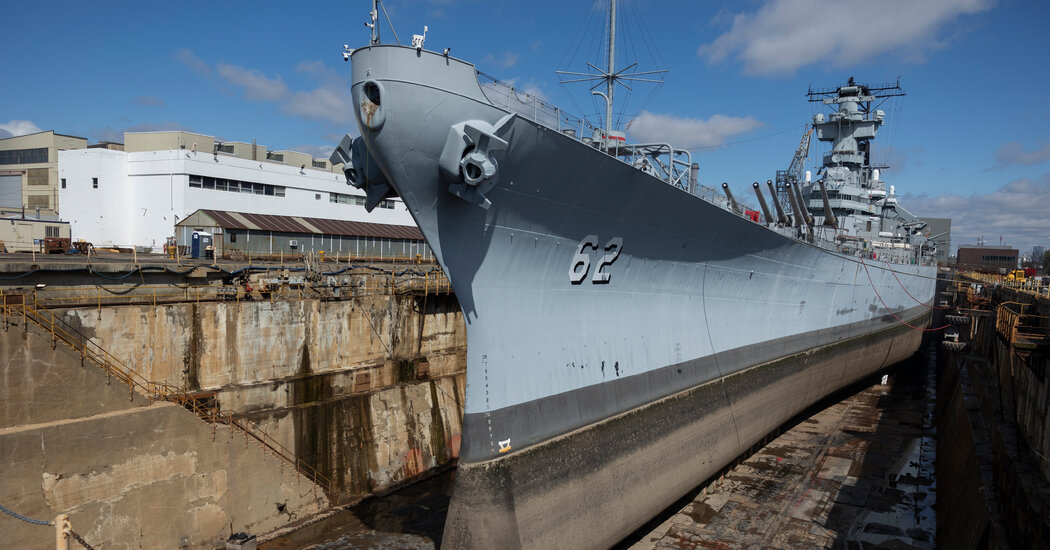The most decorated battleship in the history of the United States is done with war.
The engines of the vessel, the Battleship New Jersey, are no longer permitted to operate, by order of the U.S. Navy.
But on a windy afternoon in March, tugboats pushed and pulled the ship away from land for the first time in more than 20 years. It left its berth in Camden, N.J., en route to Philadelphia, where it was guided into dry dock to undergo two months of repairs that can only be completed out of water.
Muriel Smith was there to watch.
“You’ll get me crying,” Ms. Smith, 87, said, describing the emotions she felt as a mammoth American flag was hoisted aloft during the shifting of colors before the Battleship New Jersey left the dock on March 21. Ms. Smith, a writer who lives in New Jersey, was on hand in 1999, too, when the ship made its way through the Panama Canal, headed toward its new career as a museum and memorial.
At each event, she said, she thought about her children, two of whom served in the U.S. Marines and one, Tracie Smith-Yeoman, who retired from the Navy as a commander.
“I feel like my own kids are being honored,” Ms. Smith said about the financial commitment that enabled the monthslong maintenance project.
“All the lives that served on her,” added Ms. Smith-Yeoman, who now teaches naval science at a magnet school on the Jersey Shore. “All that she did to secure the freedoms of so many people.
“It’s important that we never, ever forget that.”
No other U.S. battleship served in more military campaigns. Christened on the first anniversary of the attack on Pearl Harbor, Dec. 7, 1942, it went on to earn 19 battle stars during 21 years of active service. Roughly 45,000 sailors and Marines served on its decks in World War II, the Korean and Vietnam Wars, the Lebanese Civil War and the Iran-Iraq Tanker War.
The ship arrived at its permanent dock in Camden in October 2001, just after the Sept. 11 attacks. For security reasons, it was a hush-hush affair. “They moved her in the middle of the night without anybody on board,” Ryan Szimanski, the museum’s curator, said.
As a museum, the battleship has become known for its hands-on military history tours and for the Scout sleepovers, retirement parties and high school proms that help to pay its bills.
It was years overdue for the routine maintenance required to keep it safely afloat for the next couple of decades in the Delaware River. And preparations for pulling the 887.7-foot ship about six miles, from Camden to Paulsboro, N.J., and then to Philadelphia, were complete even before the $10 million it will cost to finish the job was secured.
To get to Philadelphia, the battleship had to pass under the Walt Whitman Bridge, which has a low-tide clearance 26 feet shorter than the ship’s tallest point, Mr. Szimanski said.
A mast and antennas had to be removed to make it fit. And as the battleship neared Philadelphia, its onboard tanks were flooded with water to weigh it down enough to shimmy it into Dock No. 3 of the Philly Shipyard.
It took three days to drain the slip, leaving the hull fully visible for the first time in 34 years.
For weeks, workers have been hunched underneath the battleship welding waterproof caps and replacing anodes as others perch on equipment high overhead, pressure-washing and painting the hull.
Before returning to Camden in late May, the ship will have been sprayed with six coats of epoxy in three distinct colors — layering that will help museum officials track the underwater erosion process.
Weekend tours have allowed ticket holders from as far away as China and South America to walk beneath its underbelly. One man flew back and forth from California within 24 hours for the opportunity to climb down five flights of stairs into the cavernous boat basin where the work is being done.
“They don’t do this, anywhere, very often,” said Libby Jones, the museum’s director of education. “If you’re into this kind of stuff, this is it — this is the Super Bowl.”
Along the way, Mr. Szimanski has stumbled into internet fame.
A YouTube channel he and Ms. Jones created at the start of the pandemic to offer programming while the museum was closed now has nearly 240,000 subscribers. Tickets for the dry-dock tours that Mr. Szimanski leads are selling for $1,000. (Tours led by other guides are $225.)
“I think it’s crazy!” said Mr. Szimanski, 34, who grew up in Baltimore and has been working on museum battleships since he was a teenager.
He is driven, he said, by a desire to offer an authentic window into the country’s military history, including the 1,600-room battleship’s capacity for devastation and the sacrifices that have accompanied it home from war.
“Maybe that will be enough,” he said, “to remind us not to do it all over again.”

